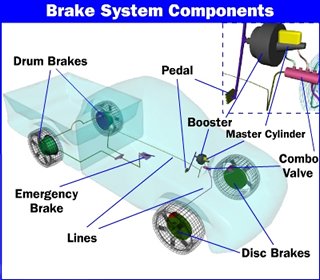Car Brakes and Brake Repair
- Disc Brakes
- Brake Rotors
- Brake Caliper
- Vacuum Booster
- Drum Brakes
- Wheel Cylinders
- ABS
- Master Cylinder
Brake repairs are one of the most common automotive problems there is. Many auto brake repair shops will be able to diagnose the problem for you. They will even fix it for you . You may, however, be able to narrow down some of the possible problems yourself. You might even be able to save some cash by fixing it yourself. most car brake repairs are easy to do with the information we provide.
This page is full of great information to help you troubleshoot your brakes and get them fixed fast. once you have figured out the problem, visit the pages listed above to see how easy or difficult your particular car brakes repair will be.
Follow these steps to determine what kind of brake repair job you are getting yourself into:
- Step off the brakes, with the car's engine turned off. A soft or mushy brake pedal indicates that you may be low on brake fluid, or may need to bleed your brakes.
- If it is safe, drive the car at low speed, braking as needed. You may need new brake pads, or to clean the brakes, if they squeal.
- In a clear area, step sharply on the brake pedal. If the brakes do not stop the car effectively, several things may be wrong, including worn pads, contaminated brake fluid or contaminated brake pads.
- If the brakes pull the car to one side, you may need to adjust the brake's clearance, may have to replace the pads or rotors, or may have insufficient hydraulic pressure in one part of the brake system.
- Begin driving forward slowly. If the brakes bind or drag, it may be due to grease on the pads or scored rotors. Visit a mechanic if you do not know how to fix brakes. Describe the car's performance to the mechanic in as much detail as you can. Check brake fluid regularly. If you have determined that your brakes are bad, avoid driving the car until they are fixed. Computerized brakes, which are standard in many cars, need to be fixed by a mechanic.

Lisle 24300 Speedy Brake Pad Spreader
- Squeeze the handle and the fast acting plunger compresses disc brake pistons in seconds
- Makes brake pad replacement an easy job

Brake Performance Troubleshooting Hints
Brake vibrations or pulsation can often be diagnosed on a safe and careful test drive. A brake vibration which is felt through the brake pedal while braking, but not felt in the steering wheel, is most likely caused by brake surface variations in the rear brakes. If both the brake pedal and steering wheel vibrate during braking, a surface variation in the front brakes, or both front and rear brakes, is very likely.
A brake pedal that pumps up with repeated use can be caused by air in the brake hydraulic system or, if the vehicle is equipped with rear drum brakes, the brake adjusters may be seized or out of adjustment. A quick test for brake adjustment on vehicles with rear drum brakes is to pump the brake pedal several times with the vehicle's engine not running and the parking brake released. Pump the brake pedal several times and continue to apply pressure to the brake pedal. With pressure being applied to the brake pedal, engage the parking brake. Release the brake pedal and quickly press the brake pedal again. If the brake pedal pumped up, the rear brakes are in need of adjustment. Do not compensate for the rear brake adjustment by adjusting the parking brake, this will cause premature brake lining wear.
To test a vacuum brake booster, pump the brake pedal several times with the vehicle's engine off. Apply pressure to the brake pedal and then start the engine. The brake pedal should move downward about one inch (25mm).Brake pedal pulsates or shimmies when pressed
- Check wheel lug nut torque and tighten evenly to specification.
- Check the brake rotor for trueness and thickness variations. Replace the rotor if it is too thin, warped, or if the thickness varies beyond specification. Some rotors can be machined; consult the manufacturer's specifications and recommendations before using a machined brake rotor.
- Check the brake caliper or caliper bracket mounting bolt torque and inspect for looseness. Torque the mounting bolts and inspect for wear or any looseness, including worn mounting brackets, bushings and sliding pins.
- Check the wheel bearing for looseness. If the bearing is loose, adjust if possible, otherwise replace the bearing.
Brakes make a squealing noise
- Check the brake rotor for the presence of a ridge on the outer edge; if present, remove the ridge or replace the brake rotor and brake pads.
- Check for debris in the brake lining material, clean and reinstall.
- Check the brake linings for wear and replace the brake linings if wear is approaching the lining wear limit.
- Check the brake linings for glazing. Inspect the brake drum or rotor surface and replace, along with the brake linings, if the surface is not smooth or even.
- Check the brake pad or shoe mounting areas for a lack of lubricant or the presence of surface rust. Clean and lubricate with a recommended high temperature brake grease.
Brakes make a grinding noise
- Check the brake linings and brake surface areas for severe wear or damage. Replace worn or damaged parts.
- Check for a seized or partially seized brake causing premature or uneven brake wear, excessive heat and brake rotor or drum damage. Replace defective parts and inspect the wheel bearing condition, which could have been damaged due to excessive heat.
Vehicle pulls to one side during braking
- Check for air in the brake hydraulic system. Inspect the brake hydraulic seals, fluid lines and related components for fluid leaks. Remove the air from the brake system by bleeding the brakes. Be sure to use fresh brake fluid that meets the manufacturer's recommended standards.
- Check for an internally restricted flexible brake hydraulic hose. Replace the hose and flush the brake system.
- Check for a seizing brake hydraulic component such as a brake caliper. Check the caliper piston for surface damage such as rust, and measure for out-of-round wear and caliper-to-piston clearance. Overhaul or replace failed parts and flush the brake system.
- Check the vehicle's alignment and inspect for suspension wear. Replace worn bushings, ball joints and set alignment to the manufacturer's specifications.
- If the brake system uses drum brakes front or rear, check the brake adjustment. Inspect for seized adjusters and clean or replace, then properly adjust.
Brake pedal feels spongy or has excessive travel
- Check the brake fluid level and condition. If the fluid is contaminated or has not been flushed every two years, clean the master cylinder reservoir, and bleed and flush the brakes using fresh brake fluid that meets the manufacturer's recommended standards.
- Check for a weak or damaged flexible brake hydraulic hose. Replace the hose and flush the brake system.
- If the brake system uses drum brakes front or rear, check the brake adjustment. Inspect for seized adjusters and clean or replace, then properly adjust.
Brake pedal feel is firm, but brakes lack sufficient stopping power or fade
- Check the operation of the brake booster and brake booster check valve. Replace worn or failed parts.
- Check brake linings and brake surface areas for glazing and replace worn or damaged parts.
- Check for seized hydraulic parts and linkages, and clean or replace as needed.
Grabby Brakes, vehicle has excessive front end dive or locks rear brakes too easily
- Check for worn, failed or seized brake proportioning valve and replace the valve.
- Check for a seized, disconnected or missing spring or linkage for the brake proportioning valve. Replace missing parts or repair as necessary.
Brake pedal goes to floor when pressed and will not pump up
- Check the brake hydraulic fluid level and inspect the fluid lines and seals for leakage. Repair or replace leaking components, then bleed and flush the brake system using fresh brake fluid that meets the manufacturer's recommended standards.
- Check the brake fluid level. Inspect the brake fluid level and brake hydraulic seals. If the fluid level is OK, and the brake hydraulic system is free of hydraulic leaks, replace the brake master cylinder, then bleed and flush the brake system using fresh brake fluid that meets the manufacturer's recommended standards.
Brakes produce a burning odor
- Check for a seizing brake hydraulic component such as a brake caliper. Check the caliper piston for surface damage such as rust, and measure for out-of-round wear and caliper-to-piston clearance. Overhaul or replace failed parts and flush the brake system.
- Check for an internally restricted flexible brake hydraulic hose. Replace the hose and flush the brake system.
- Check the parking brake release mechanism, seized linkage or cable, and repair as necessary.
Common questions when looking for other kinds of brake repair
- Where can I find information on brake line repair?
- How much do front brakes cost?
- How much do rear brakes cost?
- What are the types of car brakes?
- How do car brakes work?


